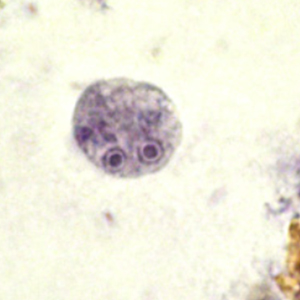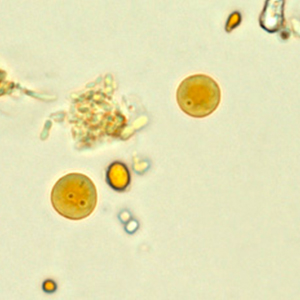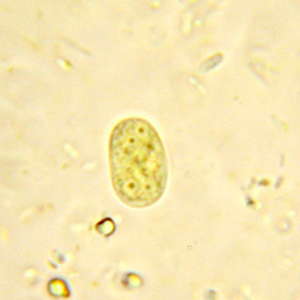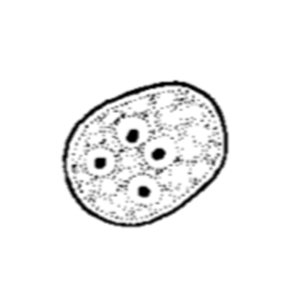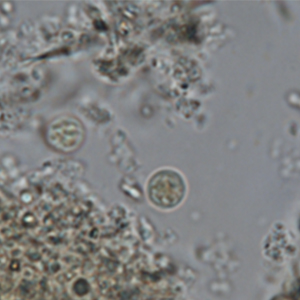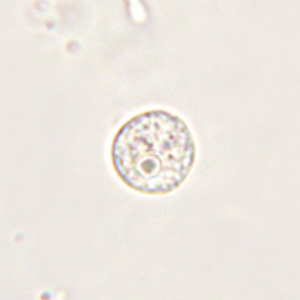Endolimax nana is an amoeba which affects the colon and cecum of primates. It is the only species of the genus Endolimax known to affect non-human primates and is a zoonotic pathogen (Cogswell, 2007).
Epidemiology
Endolimax nana is a cosmopolitan parasite described in both Old and New World Monkeys, and in Apes. Although it does not seem to be pathogenic in non-human primates, it has been described in mangabeys (Cercocebus and Lophocebus spp.), common patas monkeys (Erythrocebus patas), baboons (Papio spp.), crab-eating macaques (Macaca fascicularis), capuchin monkeys (Cebus and Sapajus spp.), chimpanzees (Pan troglotydes), and gorillas (Gorilla gorilla) (Cogswell, 2007; Zanzani et al., 2016).
Description
Endolimax nana cysts are small (5 to 10 µm in diameter) and round. They stain with Lugol. They contain one to four punctiform nuclei, with a voluminous, irregular, and eccentric endosome and without any perisome. Their outer membrane is quite thin (Euzéby, 2008; Garcia, 2021). Trichrome and iron hematoxylin stain allow a better visualization of the parasite.
Differential diagnosis
The main differential diagnosis for Endolimax nana includes small-sized amoebas, other small-sized protozoa, and non-parasitic structures. Amoebas most frequently confused with Endolimax nana are Iodamoeba butschlii and Entamoeba hartmanni. However, Iodamoeba butschlii has a more oval aspect than Endolimax nana and contains a large iodophilic vacuole inside its cytoplasm. On the other hand, Entamoeba hartmanni has only one nucleus with a punctiform nucleolus and peripheric chromatin. Other protozoa (Chilomastix mesnili, Retortamonas intestinalis, Enteromonas hominis, Giardia intestinalis) are normally rounder than Endolimax nana cysts. They also have different organelles in addition to the nucleus, which allows their differentiation (Euzéby, 2008). A trichrome or iron hematoxylin stain can underline cytoplasmic details of the parasites, hence increasing precision in the diagnosis. Finally, non-parasitic structures like spores do not contain intracytoplasmic structures and usually have a thicker and more refringent outer membrane (Petithory et al., 1995).
Clinical significance
Endolimax nana does not normally cause clinical signs.
Prophylaxis and treatment
As a non-pathogenic parasite, contamination by Endolimax nana does not require treatment. Nevertheless, hygienic measures need to be taken in case of diagnosis in a captive setting (Cogswell, 2007).
